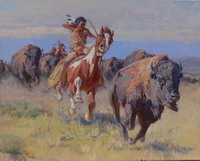Login form
North Dakota

North Dakota is nicknamed the Peace Garden State. It takes its nickname from the International Peace Garden. North Dakota shares this garden with its neighbor to the north, the province of Manitoba in Canada. The garden honors the peaceful relations between the United States and Canada.
FLICKERTAIL STATE
Before North Dakota took the nickname Peace Garden State, it was known as the Flickertail State. A flickertail is a kind of squirrel that flicks its tail just before entering its burrow. Flickertail squirrels burrow in wheat fields and cause trouble for farmers. People in North Dakota used to get money for killing these pests and turning in their tails. For this reason, North Dakotans themselves were also called Flickertails.
|
Facts About North Dakota |
|
|
|
|
|
Capital |
Bismarck |
|
Population |
634,000 people |
|
Rank among states in population |
48th |
|
Major cities |
Fargo, Bismarck, Grand Forks |
|
Area |
70,700 square miles |
|
Rank among states in area |
18th |
|
Statehood |
November 2, 1889, the 39th state |
|
State nickname |
The Peace Garden State |
|
Name for residents |
North Dakotans |
|
State bird |
Western Meadowlark |
|
State flower |
Wild Prairie Rose |
|
State tree |
American Elm |
|
Abbreviation |
ND |
GEOGRAPHIC CENTER
We think of North Dakota as pretty far north because it’s on the border with Canada. But the town of Rugby, North Dakota, is at the geographic center of North America. This means Rugby is midway between the continent’s Atlantic Coast and Pacific Coast and halfway between the northernmost point in Canada and the southernmost point of Mexico.
PLAINS AND BADLANDS
Flat plains, rolling hills, and grasslands cover much of the state. The Missouri River runs through the western half of the state. Numerous small lakes dot the land. North Dakota has short, hot summers and long, cold winters.
North Dakota is an agricultural state. It has fertile soil and is a leading producer of wheat and barley. Cattle ranching is also important.
Steep-sided, rocky hills rise from the plains in the western part of North Dakota. They’re called the Badlands. Early fur traders found the hills difficult to cross and named this land.
Although the Badlands were bad for pioneers moving west, they’re an interesting and colorful place to visit today. Minerals in the rocks turn the hills shades of lavender, green, red, and yellow. The Badlands are one of North Dakota’s main tourist attractions.
BUFFALO-HUNTING GROUNDS
Before farmers and ranchers moved in, Sioux Indians hunted bison (buffalo) on the plains of North Dakota. The name Dakota is a Sioux Indian word meaning “friend” or “ally.” The Sioux called themselves the Dakota, Lakota, or Nakota—depending on which branch of the Sioux they belonged to. Other Native Americans gave them the name Sioux.
Theodore Roosevelt came to North Dakota in 1883 to hunt buffalo, years before he became president of the United States. In 1884, he started a cattle ranch in North Dakota. Roosevelt later became an enthusiastic conservationist because of his experiences as a rancher. He set aside more land for parks and other public use than any president before him. You can visit his ranch in North Dakota’s Theodore Roosevelt National Park.
North Dakota is still a great place for viewing wildlife, including buffalo. It has more wildlife refuges than any other state. Its many water-filled potholes attract migrating geese and ducks. These pot-shaped holes in the ground were left behind by melting glaciers that once covered the region. Filled with rainwater or melting snow, they provide valuable stopover sites for waterfowl.
LEWIS AND CLARK
The Lewis and Clark Expedition spent the winter of 1804 in North Dakota, among the Mandan and Hidatsa Indians. During their stay, several new members joined the expedition, including Sacagawea. This Native American woman was a valuable guide and interpreter during the rest of their journey. You can learn about the Lewis and Clark Expedition at their rebuilt camp at Fort Mandan.
THE DAKOTA TERRITORY
In 1861, the United States Congress created the Dakota Territory. It encompassed what became North and South Dakota and most of Montana and Wyoming.
The railroad came through the Dakota Territory in the 1870s. It linked Minnesota with Washington State. The railroad companies advertised the territory’s fertile farmland in Europe, and they sold land cheaply to settlers. The railroads hoped to gain not only passengers but also shipments of farm products from the settlers.
During the 1870s and 1880s, many immigrants came to farm the Dakota Territory, especially from Norway, Sweden, Russia, and Germany. They mainly grew wheat. Ranchers called the farmers sodbusters. To farm the land, the settlers had to “bust,” or break apart, the sod (grass and soil). The matted roots of prairie grasses made it hard to bust the sod. There was no wood for building houses, and so many settlers lived in houses built from blocks of sod.
STATEHOOD
On November 2, 1889, North Dakota became a state. So did South Dakota. Because the two gained statehood at the same time, no one knows which is the 39th state and which the 40th. They are generally listed in alphabetical order, making North Dakota the 39th state.
Bismarck is the capital of North Dakota. The Northern Pacific Railroad named the community in 1873 after Germany’s prime minister, Otto von Bismarck. The railroad hoped to get money from Germany to help pay for the railroad.
The city of Bismarck is located on the Missouri River, at an easy crossing point. Fargo is the state’s largest city. Both cities are manufacturing centers for North Dakota.
Source: Microsoft ® Encarta

